Michigan vegetable crop report - August 10, 2022
Last week was ideal for disease development as Gulf of Mexico air brought high dew points.
Weather
Watch Jeff Andresen's weather update here.
Welcome to the jungle! Or at least the Gulf. The exceptionally high humidity that just broke was Gulf Air, setting the stage for extra extended periods of leaf wetness. This in turn created ideal conditions for development of some foliar diseases.
Temperatures were up to 5 degrees above-normal in much of the Lower Peninsula, with the Upper Peninsula seeing some below-normal temperatures. Up to 2 inches of rainfall fell over the past week, especially in northwest and southwest/southeast Michigan. Soil moisture has improved, though roughly half the state is still classified as abnormally dry. Degree-day totals continue to be ahead of normal to the south to behind normal in the Upper Peninsula.
The forecast calls for:
- Variably cloudy and warmer Wednesday. A chance for isolated showers overnight through tomorrow morning south.
- Mostly fair, dry and cooler Thursday through Saturday.
- Scattered showers possible Saturday night and Sunday.
- Daytime temperatures mostly in the mid-upper 70s to near 80 through the weekend. Lows from the upper 40s N to the mid-upper 50s south.
- Medium range guidance calls for generally cooler and drier than normal weather next week into the third week of the month.
Herbicide label changes
Sushila Chaudhari works on updating our Michigan weed control guide each year. She recently shared this update on new (last two years) label changes you may find useful.
Don’t delay on dodder
Dodder is a parasitic plant that spreads by seed. Once it germinates and starts vining, it attaches to host plants, and then cuts itself free from its root system, living entirely off of the energy of the host plant. Dodder is a rather confusing group of plants with some species living off of a long list of plants, and others that are specific to certain species of hosts.
It can be a mystery as to how it arrives in a particular field, but contamination of alfalfa and clover seed is one well-known way. Remove and destroy dodder as soon as it is noticed in the field. Dodder stems can also survive for a few days after being removed from host plants, so it is important that dodder stems (especially seeds) should not be left in the field. This article from University of Wisconsin-Madison Extension has more information about dodder.
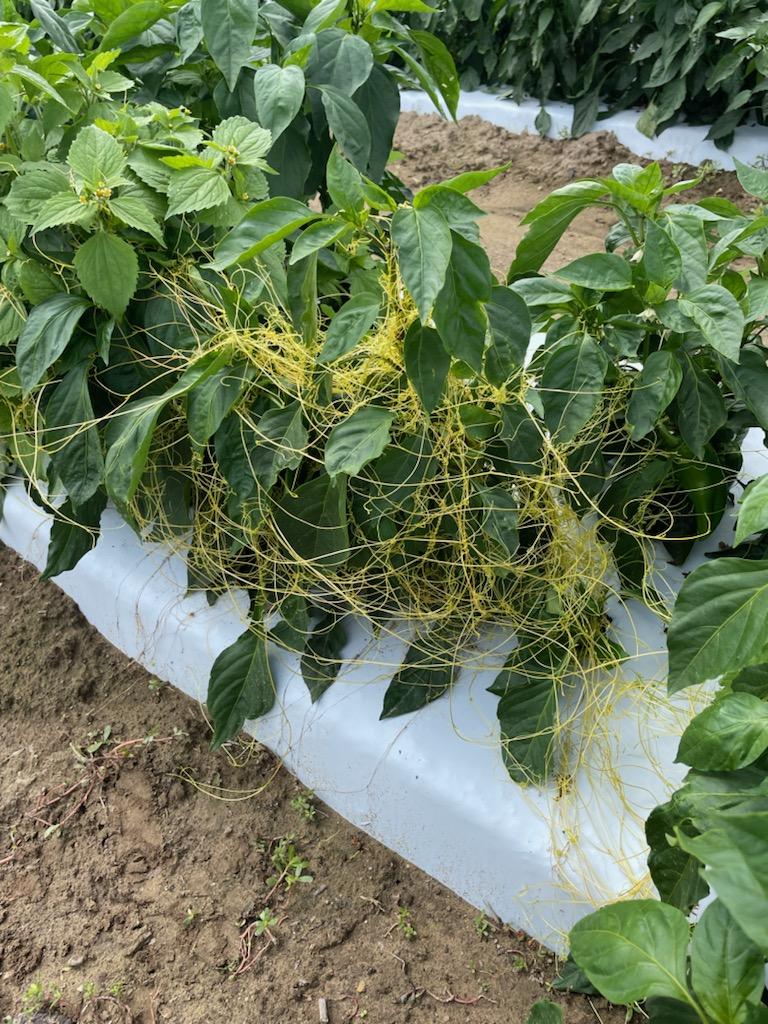
In addition to dodder, an array of grass weeds are in bloom right now on some farms. Here is a sample.
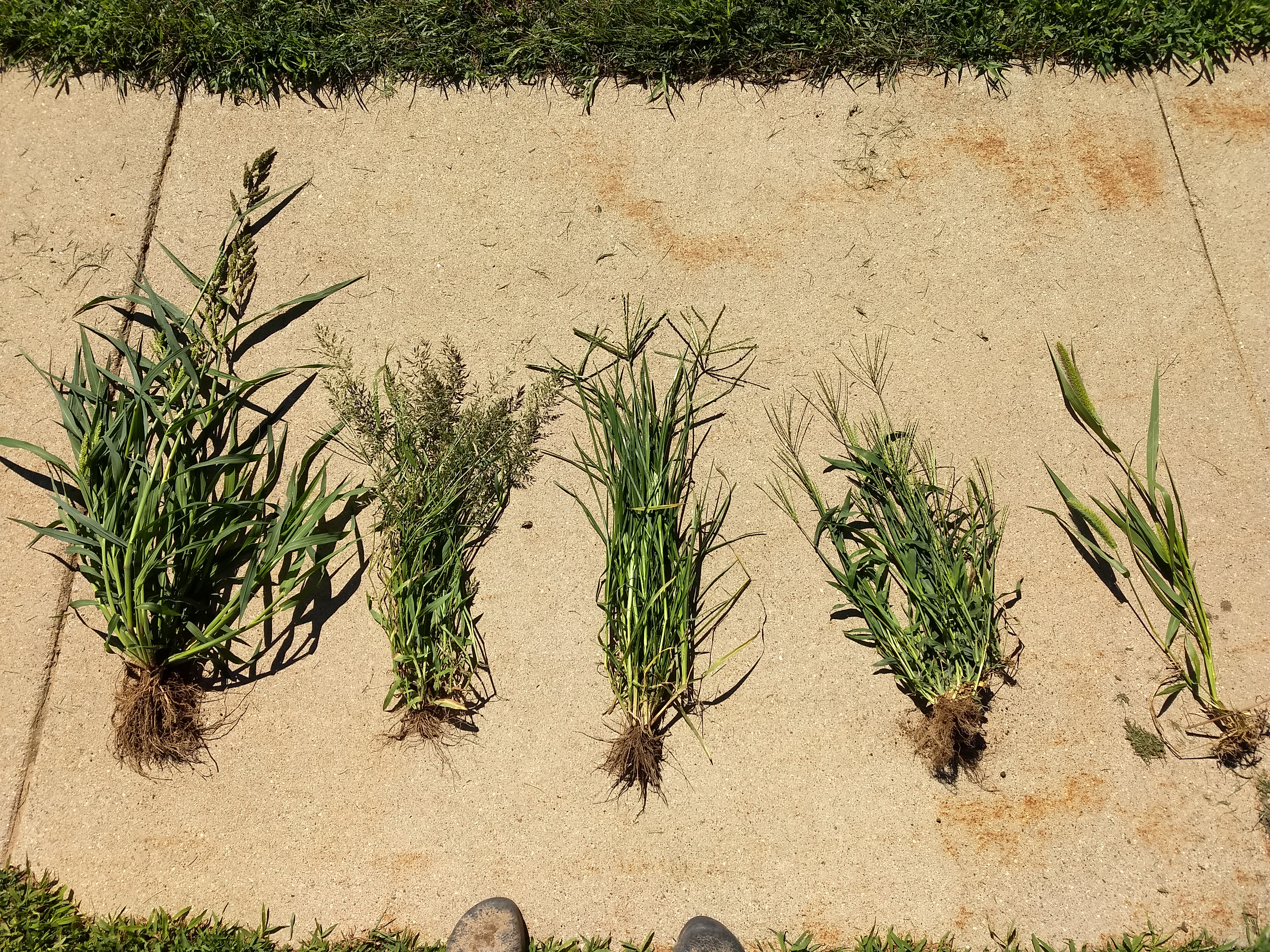
Crop updates
Asparagus
The week ending Monday was ideal for purple spot, with warm overnight temperatures and wet weather resulting in extended periods of leaf wetness. Between 11-16 Disease Severity Values (DSV) accumulated at seven asparagus fields where MSU has TomCast sensors. Unprotected fern may develop purple spot symptoms.
Mancozeb, chlorothalonil, azoxystrobin and tebuconazole are available to protect the fern. Mancozeb and chlorothalonil are protectants with activity against purple spot and rust. You can use one or the other, but tank mixing them would not provide additional protection. Chlorothalonil is considered to have longer residual activity than mancozeb based on previous MSU forecasting research plots. When rust is a concern, one of the protectants should be mixed with tebuconazole; tebuconazole is specific for rust and is our primary “go to” fungicide for this pathogen.
Carrots and celery
This is the time of year when the carrot canopy has increased to form a relatively dense canopy that restricts air movement keeping the foliage wet for longer periods of time. The recent extended period of high humidity and rainfall along with very warm temperatures will most certainly result in an increase of Alternaria leaf blight in carrot plantings. Alternaria prefers the older, mature foliage and is a yearly problem in the state. Cercospora leaf blight can also be a problem but is less common than Alternaria leaf blight. Cercospora leaf blight can be especially damaging because it attacks the new, emerging foliage. The fungicide treatment programs for each of these pathogens are the same and include either alternating or tank mixing effective fungicides such as Merivon, Luna Sensation, the strobilurins (Cabrio is an example) with chlorothalonil. The fungicide applications can be made according to the TOMCAST forecasting program.
Crop scouts report aphids continue to be present in select locations in celery. Celery leaftier caterpillars have also been present, but to date they have stayed in the top of the leaves and not moved into the heart. They typically move to the heart when it’s very hot. Variegated cutworm moths were being captured at some locations early this week, and tarnished plant bug was also present. Overall, typical critters for the time of year.
Cole crops
Diamondback moth and imported cabbage worm activity are continuing, and cabbage looper was present in one west central location this week. Cabbage looper larvae move like an inchworm and are green with white stripes. Organic growers could consider using spinosad versus Bt products if cabbage looper is present in significant numbers.
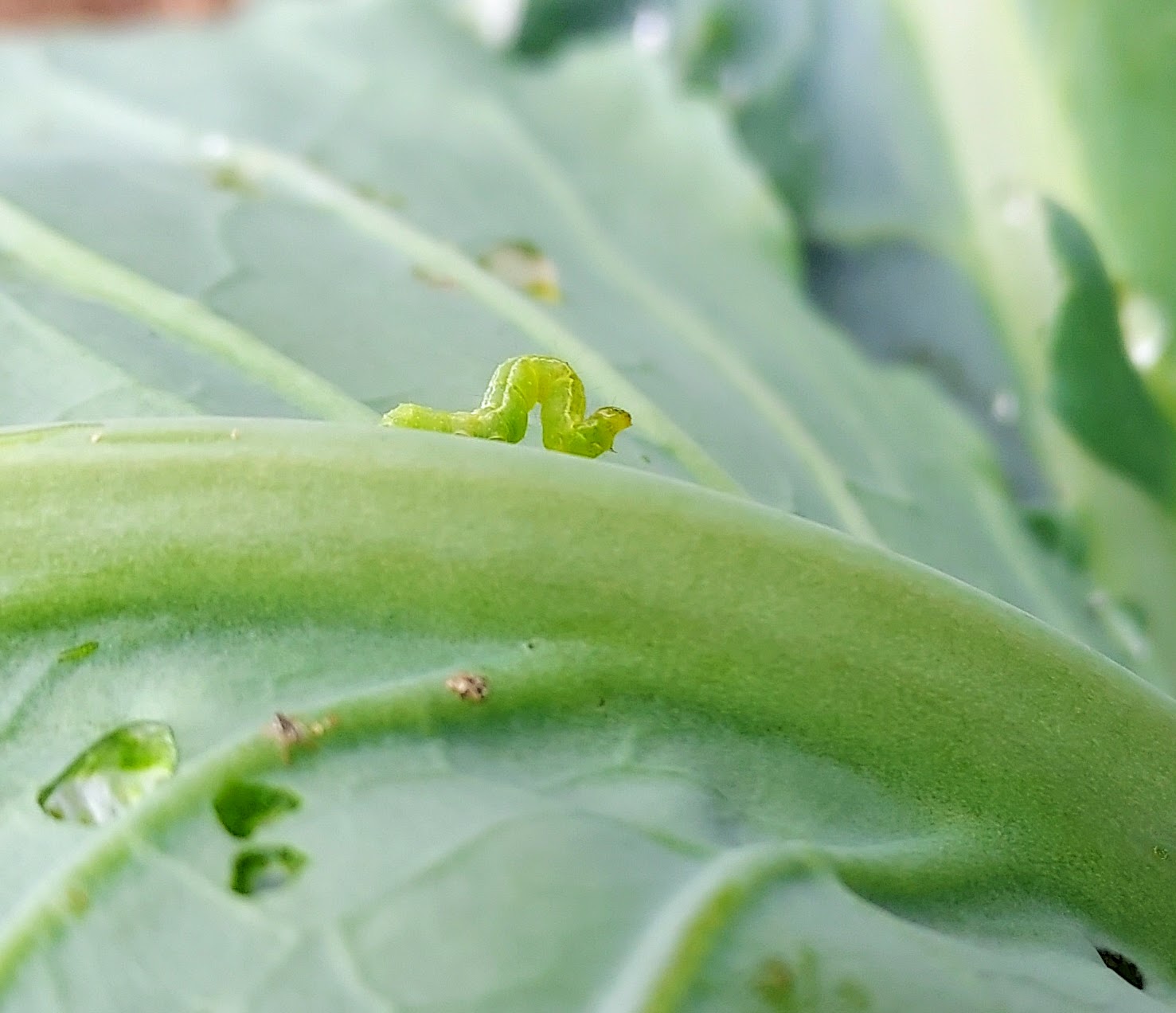
Degree days suggest the final, late-summer peak of cabbage maggot is beginning this week and next, based on weather at the Allegan, Fennville, Hudsonville and Grant Enviroweather stations. Read more about cabbage maggot control in root crops from Michigan State University Extension.
Cucurbits/pickles
Watermelons in Michigan are starting to go to market, melons are reaching peak harvest, and more types are becoming available. If you are trying new varieties of melon, it is important to let your melons teach you when to pick them. All but the netted-skin muskmelons and cantaloupes need to be cut from the vine, and do not slip off when ready. One interesting melon I’ve seen this year is Korean Melon, which grows much like a stubby cucumber. Young fruit taste like cucumber, but they are fuzzy like a peach. When yellow-ripe they are white-fleshed and crisp like an apple, with edible skin. Jack O’ Lanterns were already coloring up on two west central farms this week, with butternuts, Turk’s Turban, and acorn squash fruit on the vines and in progress. Zucchini harvest is ongoing.
Powdery mildew on pumpkins and hard squash has been reported across the state. The powdery mildew pathogen is well known for developing resistance to key fungicides because of its ability to produce vast quantities of spores which provides selection pressure on the fungicides. Based on observations and recommendations from other researchers the following fungicides could be considered in a control program for Michigan growers: Proline*, Gatten*, Aprovia Top*, Procure*, Luna Experience, and Vivando*. Fungicides with an asterisk could be tank mixed with a protectant fungicide such as chlorothalonil. Fungicides such as Quintec which had been the backbone of a powdery mildew control program are no longer recommended due to the development of resistance.
Downy mildew spores have been detected in all spore traps in the state’s network. Disease has been confirmed in cucumbers in Bay, Saginaw, Gratiot, Arenac, Muskegon, Allegan, Isabella and Ingham, and Clinton counties. A full downy mildew fungicide program is needed to protect the younger second plantings of cucumbers in the state. Given the highly favorable weather that occurred last weekend, the pressure from downy mildew on the cucumber plantings is expected to intensify. Please keep in mind that fungicides registered for and effective against powdery mildew will NOT work against downy mildew.
Onions/garlic
Early varieties like Highlander were being harvested this week in direct-sown fields on some West Central farms. The onions matured and were healthy, but water has been at a premium given the weather!
Thankfully onion thrips have been mostly under control this year on MIchigan farms. There is some concern that Radiant is no longer providing excellent thrips control. Experience in New York suggests that Exirel and Minecto Pro can provide an alternative to Radiant, to knock back populations. Exirel has a 1-day PHI, so there is more flexibility compared to Minecto Pro regards timing; don’t forget Minecto Pro contains the same actives as Agri-Mek and Exirel.
Tank-mixing a pyrethroid (like Warrior) with Lannate has been shown to provide moderate thrips control in Cornell University trials. Pyrethroids alone do not provide thrips control.
Potatoes
Harvest is just beginning. Potato late blight has not been detected in Michigan to date. The second generation of Colorado potato beetle adults is developing. These beetles do not cause as much damage; they do a bit of feeding before getting ready to overwinter.
Potato late blight forecast for Aug. 10 - Due to recent rain events, there is medium late blight risk throughout the state with areas of high risk in southern and central Michigan. No late blight has been reported in nearby regions of the U.S. One report of tomato late blight was reported in Ottawa County, Canada.
Fruiting vegetables
The full suite of fruiting vegetables is being picked now.
Anthracnose fruit rot on tomato is evident on produce available at local fruit stands. This particular fruit rot develops as the fruit ripen and results in a flattened, somewhat shiny area. These lesions can expand and coalesce resulting in large areas of the fruit becoming rotted. To prevent this, foliar fungicides are needed. Chlorothalonil has long been recognized as effective against anthracnose fruit rot and can be alternated or tank-mixed with other registered fungicides.
Stink bugs and caterpillars have been reported as key pests at this point. The main caterpillar pest is European corn borer, it bores into fruit right under the pepper cap. Stink bugs cause cloudy white spots below the skin surface.
One type of insecticide to handle both caterpillars and stink bugs is a basic contact-kill pyrethroid, like beta-cyfluthrin (Baythroid), bifenthrin (Brigade), lambda-cyhalothrin (Warrior), permethrin (Perm-Up), pyrethrins (Pyganic) or zeta-cypermethrin (Mustang Max). However, regular use of these broad-spectrum contact killers can result in thrips populations exploding because many of their natural enemies are taken out along with the pests. Later in the season, it takes longer for thrips populations to build up, and so a pyrethroid applied then would have less of a chance to cause a flare up. Early in the season, judicious use is advised, guided by scouting.
There are several selective insecticides for caterpillars, stink bugs and thrips. Scouting can dictate whether one is a bigger concern than another.
For thrips
One of the best thrips-eaters are minute pirate bugs, which can fly in from surrounding areas and thrive on thrips, nectar and pollen. If your crop has all three, they will be there. In fact, ornamental peppers are used in greenhouses as “pirate bug generators” like motherships to provide thrips control of other plants indoors. Much like a greenhouse, recolonization of pirate bugs after a pyrethroid spray in the field depends on how you have managed and arranged the surrounding landscape with flowering plants. Out-of-control thrips populations can be reined in with products like spinetoram (Radiant), which also has caterpillar activity and is soft on beneficials. If it is later in the season, Assail could be used for thrips; it kills pirate bugs, but as noted above, later in the season there is less time for thrips to cause issues.
For caterpillars
One other well-tested field biocontrol for European corn borer (ECB) is the Trichogrammid wasp. This egg-parasite is timed for release in corn fields just when ECB is laying eggs (based on environmental models), and then the wasps lay their eggs into the ECB eggs, killing the next ECB generation. I am not aware of work on this in fruiting vegetable systems, specifically. However, it is an interesting opportunity, and application technology of biocontrol insects seems to keep improving. This French group has been using drones to airdrop the wasps. This may be something interesting to investigate in future research in North America.
On the insecticide front, if caterpillars (European corn borer) are your main problem, chlorantraniliprole is highly effective and can be applied as a spray or via chemigation. It is soft on beneficial insects. Radiant is also effective and does dual-duty against thrips. There are other caterpillar specific products available too, such as Avaunt and Intrepid, that can stand in before/after the main period of Corn borer concern. Bt is a good organic option, but more frequent applications (e.g., twice per week) may be required.
One last note: The European corn borer degree-day model can provide a rough guide for you regards when to worry about this pest (and focus highly effective products such as chlorantraniliprole). It’s not a substitute for field scouting, and other caterpillars can cause issues on into the fall (e.g., fall armyworm).
For stink bugs
With these pests being able to feed on dozens of plants, and being powerful fliers, suppression provided by natural enemies is less in your control. Brown marmorated stink bug is an invasive insect from another part of the world, and field-releasable biocontrols for brown marmorated stink bug are not yet available, though some egg parasitoids and pathogens have been found doing some background suppression. To treat for stink bugs with the least possible impact on other beneficial insects, systemic products like neonicotinoids (Assail, Actara, Scorpion, Sivanto, others) applied through drip irrigation offer the best route. Of those listed, data supports that acetamiprid (Assail) has the smallest impact on pirate bugs specifically.
Sweet corn
Corn earworm captures were relatively low (still worth spraying, but not at “wormageddon” levels) at an Ottawa and Oceana County location for the week ending Monday, with Western bean cutworm moths still flying. It is worthwhile checking your traps, as weather was conducive to northeasterly flights earlier in August. Insectforecast.com suggests very limited risk of additional migration through the weekend as northwesterly flow occurs (bringing the nice, cooler weather).
One crop scout noted that-so far-observations of ears have matched the trap data. Some corn earworm, but not super high levels. Of course, what is high depends on buyer tolerance!
Is mechanical harvesting just for the big guys? Not necessarily. It is interesting to see how different sized farms take different approaches, specifically, hand-harvest vs machine-harvest. Both have pros and cons. On the machine side, mechanical harvesters move the labor out of the field and into a less itchy, dewy and sweaty environment—a packing line—making harvesting sweet corn a more employee friendly endeavor. However, mechanically harvesting through a smut-infestation can make a smeared black mess of ears in the bin, which then need separating or peeling in the pack house. A hand picker would have just avoided those ears in the first place. It is fun to see how older equipment is put to innovative use on veggie farms!
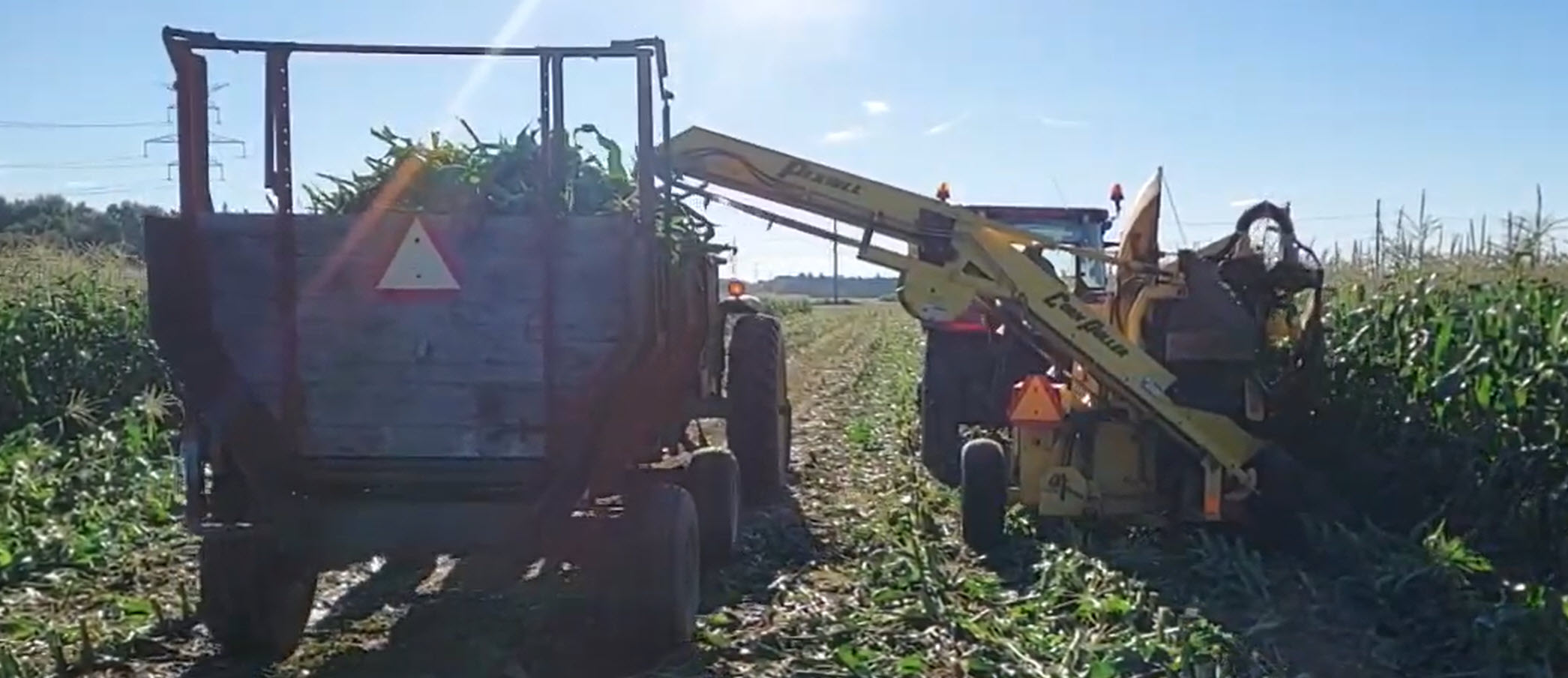
Tar spot has been developing in field corn in Michigan and could be something to at least be aware of in sweet corn, so you know what it is if you see it. Here is a nice field corn-centric update from MSU Extension.
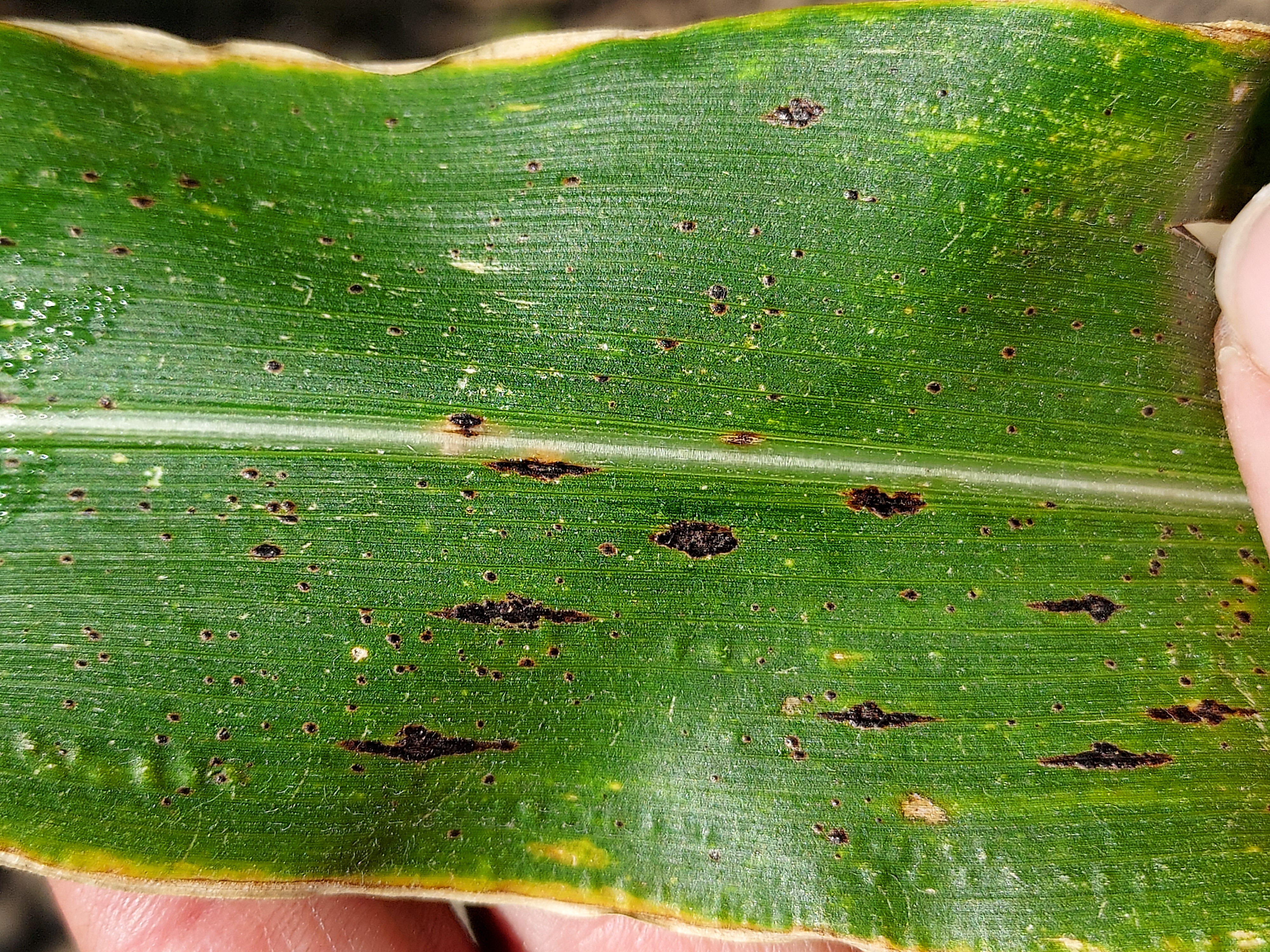
Events
- Aug. 11: Field Day and Pasture Walk at the Lake City Research Center. The center is located at 5401 W. Jennings Road in Lake City and works primarily in livestock management.
- Aug. 17, 10 a.m. - 12:30 p.m.: Grafted Tomatoes: Research Updates for Commercial Growers. Online through University of Minnesota.
- Aug. 23: Plant Diagnostic Day at the Saginaw Valley Research and Extension Center. The center is located at 3775 S. Reese Road in Frankenmuth.
- Aug. 24: Blueberry field day at the Trevor Nichols Research Center. The center is located at 6237 124th Ave. in Fennville, Michigan.
- Aug. 25: 2022 Tile Drainage Field Day at 13000 Bird Lake Rd, Camden, MI.
- Sept. 8: Field Day at the Northwest Michigan Horticulture Research Center. The center is located at 6686 S. Center Highway in Traverse City and will highlight Michigan fruit advancements.
- Sept. 14: Mechanical Weed Control Field Day at the Southwest Michigan Research and Extension Center. The center is located at 1791 Hillandale Road in Benton Harbor.
This work is supported by the Crop Protection and Pest Management Program [grant no 2021-70006-35450] from the USDA National Institute of Food and Agriculture.



 Print
Print Email
Email




